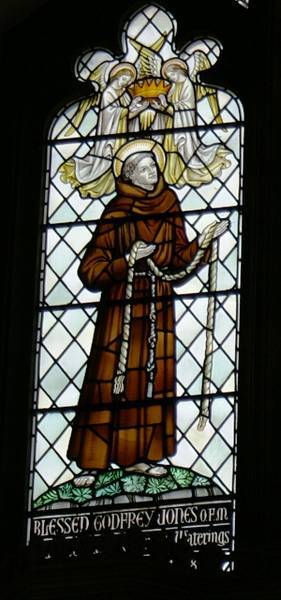Saint John (Godfrey) Jones
Dates: 1530? - 1598
John Jones was born to a Catholic family in Clymag Faur in the county of Carnaervon in Wales around the year 1530. In his youth Queen Mary Tudor accomplished the restoration of the Catholic Church after the brief reign of Edward VI had taken the Church of England into the Calvinist fold. Mary's accession had allowed the English friars who had fled into exile to Flanders and Scotland to return and in April 1555 the friary at Greenwich, in which Mary and Elizabeth had been baptised, was reopened. John joined the friary and took the name Godfrey Maurice, becoming known for his piety. At Mary's untimely death in 1558, however, her half-sister Elizabeth assumed the throne and it was not long before Catholics were once more persecuted in England. John Jones, although still a novice was forced to flee to France. The English Observant Franciscans fled to a friary in Pontoise where John was professed and trained. He was probably ordained a priest at Rheims, where there was another friary of the exiled English Province.
Towards 1590 John was sent to the friary of Ara Coeli in Rome, the general headquarters of the Order. From there he wished to return to England to take part in the mission to care for faithful Catholics, who risked their livelihoods and often their lives to sustain their missionary priests. The priests themselves were subject to the gruesome death of hanging, drawing and quartering as traitors for the simple fact of exercising their priesthood. John begged an audience with the Pope and Clement VIII embraced him, gave him a solemn blessing and told him: “Go, because I believe you to be a true son of Saint Francis. Pray to God for me and for his holy Church."
In England John Jones exercised an heroic hidden ministry, animating the Catholic faith among recusants [1] and prudently seeking to reconcile those who had submitted to Elizabeth's Church of England. The existence of a missionary priest in England was one of frequent moves, constant vigilance and continued flight from Elizabeth's vigilant secret services, supervised by William Cecil and Francis Walsingham.
Despite his care, John Jones was caught in late 1595 or early 1596 by Richard Topcliffe, who nurtured a cruel hatred for the Catholic faith and was sanctioned by the Queen to maintain a private torture chamber in his house for the Catholic priests he apprehended. John Jones was accused of being a spy and sent to the notorious Clink prison, from which we derive the expression “being in clink”. There he languished for nigh on two years awaiting trial. In prison Jones continued his ministry and converted many, including Saint John Rigby, who was himself martyred two years after John Jones (on 21st June 1600).
On 3rd July 1598 John Jones was finally brought to trial for having exercised his ministry as a Catholic priest in England. He was sentenced to hanging, drawing and quartering at Saint Thomas Watering, but was meanwhile imprisoned at Marshalsea prison. The Jesuit Henry Garnet recounts in a letter that on 12th July 1598 John was tied to a trellis and dragged to the place of his torment. He was held there for an hour before execution during which time Topcliffe harangued the crowd with his supposed crimes. Garnet recounts that the crowd was touched more by John's prayers than by the calumnies of his torturer and executioner. His remains were hung up on the road between Newington and Lambeth. [2]
With John Wall and 38 other English martyrs, John Jones was beatified by Pope Pius XI on 15th December 1929 and canonised by Pope Paul VI on 25th October 1970.
[1] Catholics who did not submit to Elizabeth's Church were forced to pay a tax and refused the right to hold any office in the land (rather like the Christian dhimmi in lands controlled by Muslims). Because they refused to take communion at Easter in their local parish churches, they were deemed to “recuse themselves” from the church and were thus recorded as “Recusants.” This title became a badge of pride for Catholic families who refused to submit over the centuries. Some Catholics conformed outwardly, so avoiding the tax, while retaining a spiritual resistance. These latter were termed “Church Papists” because although they outwardly conformed to the Church of England, inwardly they still retained their allegiance to and communion with the Church of Rome. Many think that Shakespeare was such a “Church Papist”. Often a Catholic husband would conform so as to avoid the household paying taxes, while his wife would recuse and bring up the children as Catholics.
[2] F. Bracci and A. Pozzebon. Frati Minori Santi e Beati. Rome: Postulazione Generale Ordine dei Frati Minori, 2009. p. 261-2.

St John (Godfrey) Jones depicted (while still Blessed) to the left in a window above the High Altar in the Franciscan church at Chilworth.
Memorial Day: 12th July
